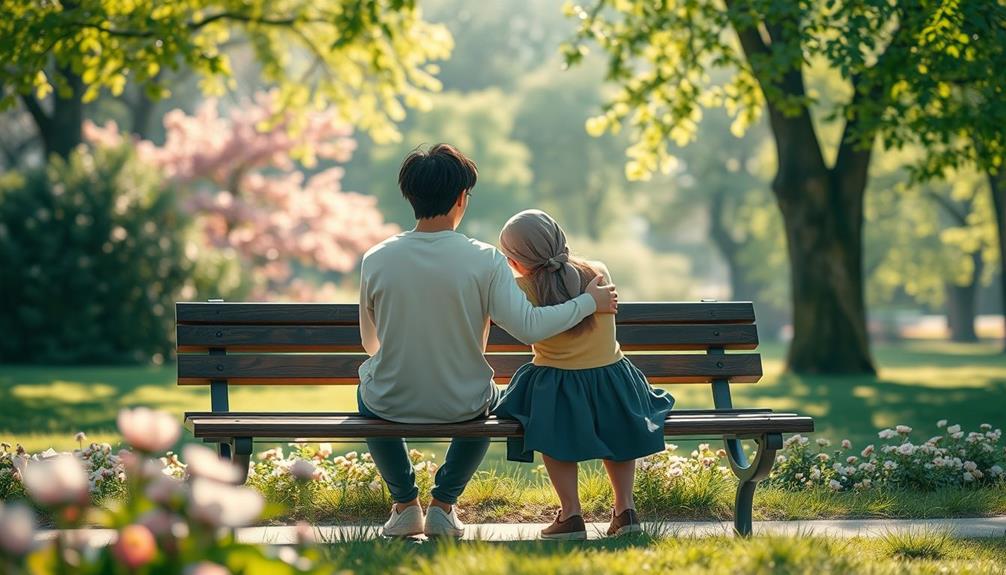There's a deep connection between Borderline Personality Disorder (BPD) and creative expression. Your emotional intensity plays a significant role, driving you to explore unique artistic avenues. This heightened sensitivity can inspire profound art that communicates what words often can't. Engaging in creative outlets not only helps with emotional regulation but also enhances self-awareness. You might find that various mediums—like painting, writing, or music—allow you to channel intense feelings into something manageable. As you explore this connection further, you'll discover more ways creativity can transform your emotional experiences and foster resilience.
Key Takeaways
- Individuals with BPD often experience heightened emotions, providing a rich source of inspiration for creative expression in various art forms.
- Artistic practices serve as therapeutic outlets, helping individuals with BPD regulate emotions and gain self-awareness through creative exploration.
- The impulsivity associated with BPD can drive spontaneous and unique artistic endeavors, leading to innovative expressions of complex feelings.
- Different artistic mediums, such as painting and writing, allow for non-verbal communication of emotions, facilitating deeper understanding and connection.
- Community engagement in art fosters empathy and safe spaces, enabling individuals with BPD to share experiences and build resilience through collaborative projects.
Understanding BPD and Creativity
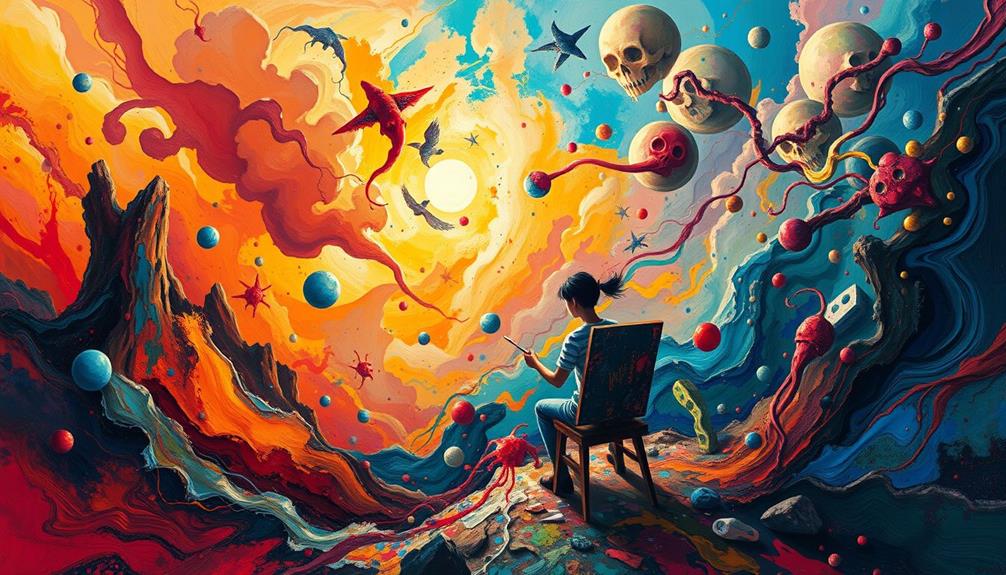
Many people mightn't realize the strong link between Borderline Personality Disorder (BPD) and creativity. Individuals with BPD often experience heightened emotional sensitivity and intensity, which can profoundly influence their artistic endeavors. This deep emotional wellspring fuels creativity, allowing you to express unique perspectives that others might overlook.
The symptoms of BPD, such as intense emotions and impulsive behavior, can drive individuals toward creative outlets, serving as a form of emotional regulation and expression. This connection between diagnosis criteria and creative expression can be particularly powerful in helping individuals process their experiences.
When you analyze your experiences more deeply than the average person, it opens doors to innovative ideas and profound artistic works. It's not uncommon for those with BPD to use creative expression as a coping mechanism, helping to navigate intense emotional experiences.
Notable figures like Sylvia Plath and Jim Morrison showcase how the intersection of creativity and emotional struggle can yield impactful art that resonates with audiences. Their works illustrate that the emotional depth stemming from BPD can lead to compelling storytelling and artistic expression.
Understanding this connection highlights the potential for art to serve as a therapeutic outlet for you, enabling you to visualize and communicate complex emotions. By embracing this link, you can harness your emotional experiences to fuel your creativity and create meaningful art that reflects your inner world.
The Role of Art in Expression

Art gives you a powerful way to communicate emotions that words often can't capture. It creates a safe space for you to explore your feelings and enhances your self-awareness through creative expression.
Engaging with various art forms can also provide therapeutic benefits, as music therapy integration has been shown to enhance emotional well-being. By engaging with art, you can navigate the complexities of your emotional landscape while connecting with others who share similar experiences.
Non-Verbal Emotional Communication
Through the lens of non-verbal emotional communication, art emerges as a powerful tool for individuals with Borderline Personality Disorder (BPD) to convey feelings that often evade verbal expression. For you, creating art can serve as a crucial outlet for emotional expression, allowing you to articulate complex emotions through colors, shapes, and forms.
Engaging in creative activities, much like providing proper care for a pet, can foster a sense of responsibility and routine that benefits emotional well-being, as seen in hamster care costs. When words fail, your artistic creations can reflect the emotional turbulence you experience, with dark hues possibly indicating depression or vibrant colors representing joy.
Engaging in artistic activities enhances your self-awareness and boosts your self-esteem, helping you navigate the intense emotional conflicts that accompany BPD. As you immerse yourself in various creative mediums, you visualize fluctuating emotions and thought patterns, transforming chaos into a structured form.
This process not only facilitates emotional release but also cultivates a clearer self-image. Regular participation in art-making acts as a coping mechanism for regulating your emotions, providing a structured way to manage mood swings.
Ultimately, non-verbal communication through art offers you an enriching pathway to understanding and expressing your feelings, helping you connect with yourself and others in a profound way.
Safe Space for Exploration
Creating art not only serves as an emotional outlet but also establishes a safe space for exploration and expression. For individuals with BPD, art provides a unique way to navigate complex emotions without the fear of judgment.
Engaging in creative outlets can be particularly beneficial when celebrating love and legacy through cherished moments, as seen in heartfelt expressions of love.
Here's how engaging in creative outlets can help:
- Non-Verbal Communication: Art allows you to express feelings that might be hard to articulate, bridging gaps in communication.
- Emotional Regulation: Engaging in creative practices enables you to visualize your inner experiences, which is essential for managing fluctuating emotions.
- Community Connection: Sharing your artwork fosters connections with others, enhancing empathy and understanding among peers.
Enhancing Self-Awareness Through Creativity
Many individuals find that engaging in creative activities can greatly enhance their self-awareness, especially when steering through the complexities of Borderline Personality Disorder (BPD). Art therapy is particularly effective, helping you explore feelings and emotional conflicts that often feel overwhelming. By using visual art, you can create a structured outlet for processing your emotions, which fosters both self-awareness and self-esteem.
When you engage in personal art practices, whether through painting, writing, or music, you provide yourself with alternative means of expression. These forms of creativity can bridge gaps in verbal communication, vital for traversing your emotional landscape.
Regular participation in art-related activities serves as a coping mechanism, allowing you to better understand and manage your complex feelings during emotional fluctuations.
Moreover, sharing your artwork can empower you, fostering empathy and building connections within your community. This sense of connection is fundamental for enhancing self-awareness and emotional support.
Therapeutic Benefits of Creative Outlets
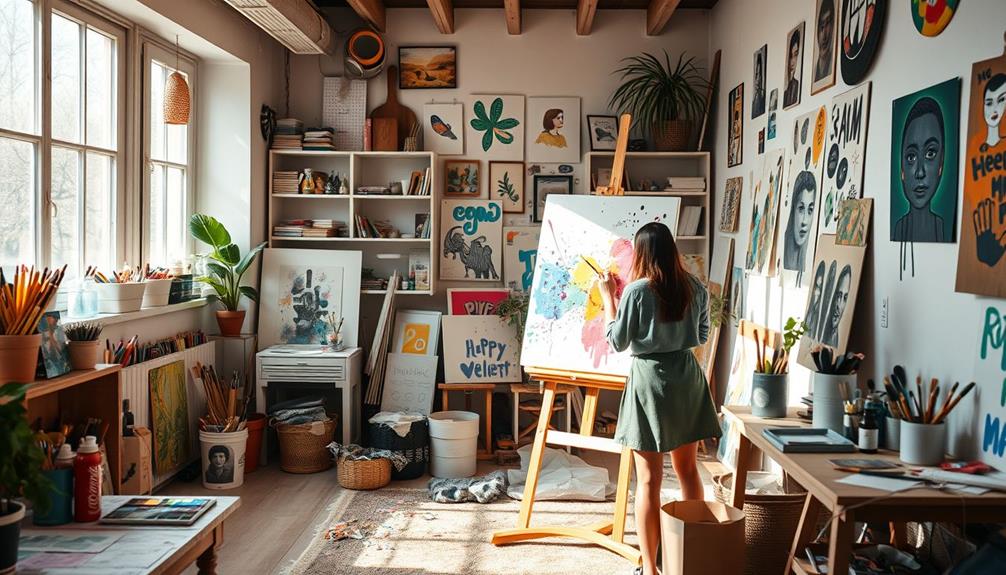
Creative outlets offer significant therapeutic benefits for individuals with Borderline Personality Disorder (BPD). Engaging in creative expression can be a powerful tool for emotional regulation, helping you navigate the intense feelings often associated with BPD.
By immersing yourself in artistic activities, you can explore your emotions in a safe space. Additionally, tapping into your creativity not only enhances self-awareness but also cultivates a growth mindset essential for personal development, as creativity fosters resilience and adaptability in the face of challenges the importance of artistic expression.
Here are three key benefits of incorporating creative outlets into your routine:
- Enhanced Self-Awareness: Art therapy encourages you to reflect on your feelings, allowing you to understand your emotional landscape better.
- Coping Mechanism: Regularly participating in creative activities provides a structured way to manage your emotions, turning overwhelming feelings into something tangible and manageable.
- Community Connection: Sharing your artwork fosters empathy and builds connections with others, promoting understanding of your emotional experiences.
These therapeutic benefits not only boost your self-esteem but also empower you to express complex feelings that might be difficult to verbalize.
Art Integration in BPD Management
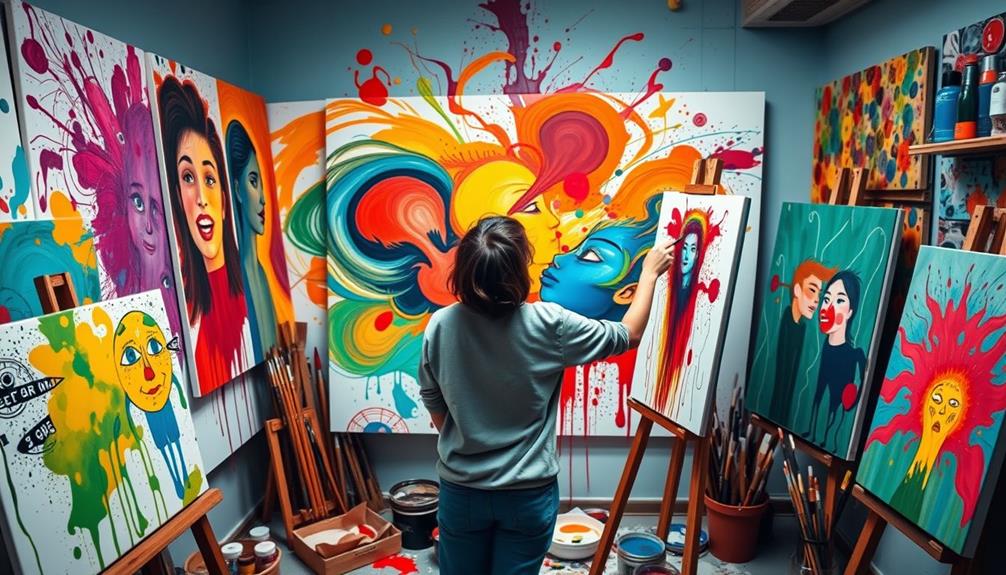
Art therapy can be a powerful tool in managing BPD, helping you explore and express your emotions creatively.
By engaging in personal art practices, you can boost your self-esteem and develop better emotional regulation.
Additionally, sharing your artwork in supportive spaces fosters community connections and empathy, enhancing your overall well-being.
Benefits of Art Therapy
Engaging in art therapy offers individuals with Borderline Personality Disorder (BPD) a unique avenue to explore their emotions and conflicts. This therapeutic approach not only encourages creative expression but also provides several key benefits:
- Enhanced Self-Awareness: Art therapy helps you gain insight into your feelings, fostering a deeper understanding of your emotional landscape. Additionally, utilizing calming essential oils like lavender oil during your creative process can further enhance relaxation and emotional clarity.
- Empowerment and Self-Esteem: As you create, you may experience a sense of accomplishment and personal empowerment, boosting your self-esteem.
- Effective Coping Mechanism: Regular participation in art activities allows you to manage emotional fluctuations more effectively, providing a non-verbal outlet for complex feelings.
Structured support from trained art therapists creates a safe environment for you to visualize and articulate emotions. Sharing and discussing your artwork within a therapeutic setting promotes community connections and fosters empathy among participants.
Personal Art Practices
Personal art practices play an essential role in managing Borderline Personality Disorder (BPD) by allowing individuals to channel their intense emotions through various creative outlets. Engaging in activities like painting, writing, or music can serve as crucial coping mechanisms for individuals diagnosed with BPD. By regularly creating art, you promote emotional regulation and self-care, which can help mitigate the emotional fluctuations that often accompany this disorder.
Additionally, risk management strategies can be applied to personal art practices, helping individuals to navigate their emotional landscape more effectively.
Art-making fosters self-awareness as you visualize and express your feelings, leading to enhanced self-understanding and boosted self-esteem. When you share your artwork in supportive environments, it can empower you and foster empathy, connecting you with others who may share similar experiences.
Incorporating personal art practices into your daily routine can greatly contribute to your overall well-being. It provides a structured way to explore and manage your complex emotional states, turning turmoil into creativity.
Community Engagement Through Art
How can community engagement through art transform your experience with Borderline Personality Disorder (BPD)? By participating in community art activities, you can build social connections that help reduce feelings of isolation, leading to better emotional regulation.
Engaging in creative outlets may also offer benefits similar to the therapeutic effects seen in practices like celery juice detoxification, where individuals can experience heightened emotional clarity and well-being.
Here are three ways these collaborations can benefit you:
- Foster Empathy: Working on collaborative art projects allows you to share your experiences and hear others' stories, creating a supportive environment essential for understanding and empathy.
- Develop Coping Strategies: Engaging in creative outlets helps you navigate intense emotional experiences, providing you with practical tools to manage your feelings effectively.
- Increase Self-Awareness: Regularly participating in community art initiatives boosts your self-esteem and helps you articulate your emotions more clearly, giving you insights into your inner world.
These structured programs create a safe space for emotional exploration, promoting resilience among individuals living with BPD.
By integrating art into your life, you not only express yourself but also connect with others who truly understand your journey.
Embrace community engagement through art; it can be a powerful step towards healing and self-discovery.
Exploring Various Artistic Mediums

Many individuals with BPD find solace and understanding through various artistic mediums, each offering a unique outlet for expression. Painting serves as a powerful way to visualize your emotions; the colors you choose can reflect your mood shifts, with dark hues signaling moments of depression.
Additionally, engaging in creative activities can also foster relaxation and boost overall well-being, similar to how coffee-related DIY projects promote creativity. Writing, on the other hand, allows you to articulate complex inner experiences, creating a form of visual storytelling that captures your journey.
Music composition lets you translate your feelings into melodies, connecting your emotional landscape with the world around you. Through dance, you can physically embody your emotional states, allowing movement to express what words sometimes cannot.
Sculpting provides a tangible way to channel your intense feelings, turning abstract emotions into physical forms that can be seen and touched. Each of these artistic mediums not only fosters creative expression but also serves as a therapeutic tool, helping you process and communicate your experiences.
The Impact of Emotions on Art
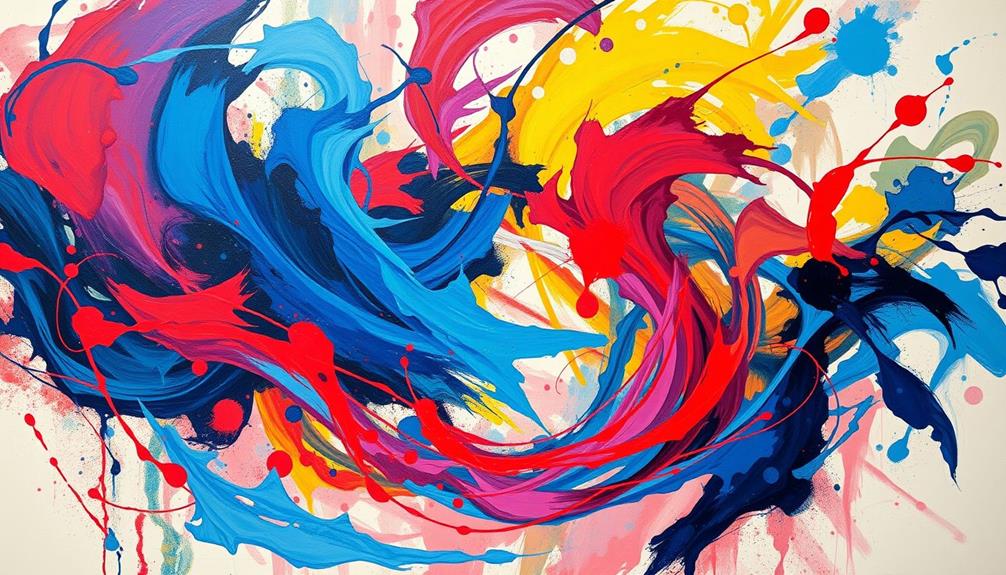
Through the lens of heightened emotional sensitivity, individuals with BPD often translate their tumultuous feelings into striking works of art. This intense connection to their emotions manifests in various creative outlets, allowing them to express what words sometimes can't. For instance, the song "Blue Skies and Lemonade" by Rhythm Failure embodies a radiant and heartwarming essence that captures moments of joy, paralleling the emotional journeys many experience.
Here's how their emotional experiences impact their art:
- Color Choices: You might notice darker palettes reflecting feelings of depression and distress, while brighter hues can signify moments of joy or relief.
- Themes: The subjects explored often investigate pain, loss, and longing, providing an authentic glimpse into their inner world.
- Mediums: Many individuals channel their emotions through diverse forms, such as painting, writing, and music composition, each serving as a crucial coping mechanism.
Art-making not only offers a way to visualize complex feelings, but it also fosters greater self-awareness and emotional regulation.
Notable artists like Sylvia Plath and Vincent van Gogh exemplify how emotional depth enhances creativity, resulting in powerful artistic legacies. Embracing this emotional sensitivity can lead to profound artistic expressions that resonate deeply with both the creator and the audience.
Conclusion
In embracing the chaotic dance of BPD, you find solace in creativity's calm embrace. Your emotions, fierce and tumultuous, become the brushstrokes of your art, revealing beauty in turmoil. While the struggle can feel isolating, the act of creation connects you to a broader narrative, transforming pain into powerful expression. By integrating art into your journey, you not only explore your inner world but also illuminate the path for others, showing that fragility can coexist with strength.

